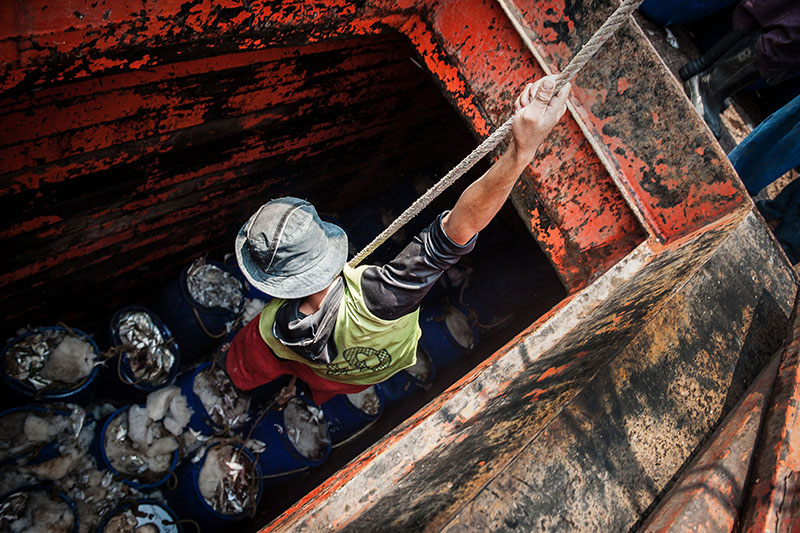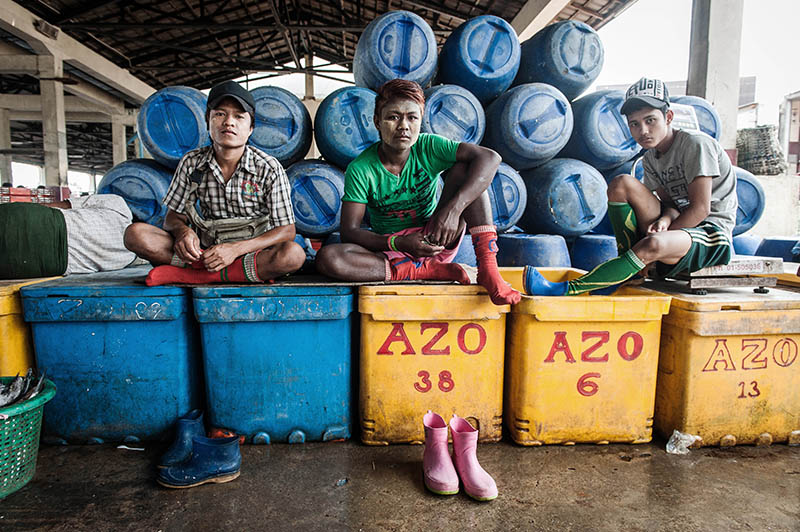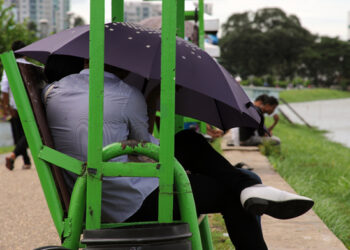RANGOON — Near Rangoon’s downtown business hub, on the banks of the Pazundaung Creek, lies a unique and lively neighborhood. Nyaung-dan jetty, located between the Thaketa and Maha Bandoola bridges, paints a gritty tapestry of livelihoods as day laborers, fishermen and their captains, and merchants play out their everyday lives. Small wooden boats rowed by men wearing bamboo hats to shield them from the blazing tropical sun ferry passengers to and fro as groups of large fishing trawlers unload blue barrels filled with their catch, the product of what can be months at sea.
Most of these fishing boats set a course for the Gulf of Martaban or the Arakan coast four times a year, with each trip lasting about three months. After spending about a dozen weeks isolated at sea, the fishermen return to Rangoon to drop off their catch, staying ashore for about 10 days. This brief window is the only time that family members of the fishermen, some of whom are not from Rangoon, get the chance to reunite with their loved ones before they pull up anchor and ready themselves for another three months on the water.
The fishermen who work on these trawlers at Pazundaung creek mainly come from Lower Burma and earn a salary of around 100,000 kyats (US$100) a month for their labor. There are about 30 groups of boats with about 15 boats in each group. Each boat has about 25 people onboard. Most of the fishermen are unmarried, young men whose ages range from 20 to 35 years old.
Ye Min Htun comes from Bilu Gyun, a pastoral island across the river from the city of Moulmein in Mon State, and has been working as a fisherman for eight years. The 23-year-old started when he was 15, joining his elder brothers who were already in the profession. He said he dropped out of school after sixth grade not because of poverty but because life in his village bored him.
He earns a salary of 100,000 kyats and makes some extra money, typically another 100,000 kyats, by selling fish caught but not wanted by the fleet owner, which he and his fellow fishermen dry on the boat while at sea. “A lot of people go to foreign countries now. There aren’t many people left in this profession,” said Ye Min Htun, pointing to fishermen’s meager income as reason for its dwindling appeal.
Unlike most of the crews, Ye Min Htun’s trawler only stays out at sea for 10-15 days at a time, after undertaking a 20-hour journey to the fishery. Their employer provides the food, water, oil and other necessary provisions.
Another essential item for the crew is their government-issued “fisherman IDs.”
“We get into trouble if we can’t show IDs to military boats. Sometimes you can even get arrested,” said Ye Min Htun.
Life on the boat is not easy. The fishermen rarely get enough sleep. They have to cast out a net that sinks to the ocean floor and haul it in every four-and-a-half hours. After the net has been hauled onboard, the catch must be sorted by type of fish, and then packed with ice in the large blue barrels.
This process plays out day after day, regardless of weather conditions.
“The work is not so tiring,” Ye Min Htun said. “It’s just that we don’t get enough sleep.”



























